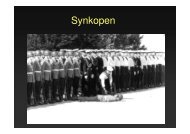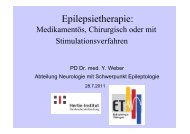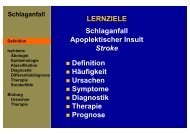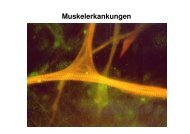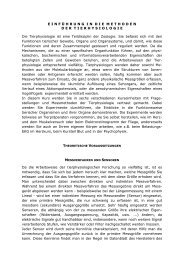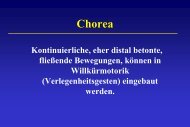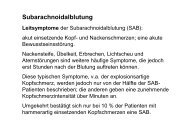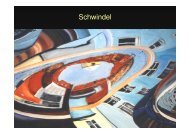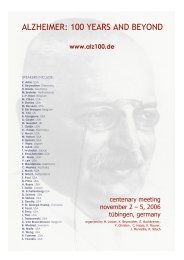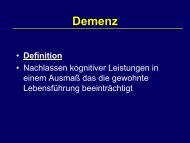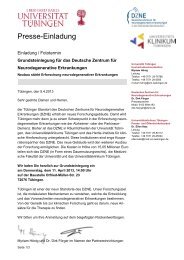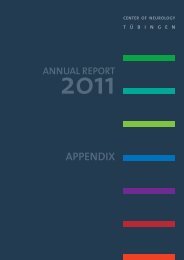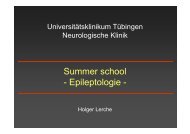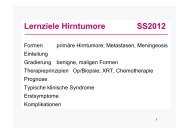scientific meeting - overview - Hertie-Institut für klinische Hirnforschung
scientific meeting - overview - Hertie-Institut für klinische Hirnforschung
scientific meeting - overview - Hertie-Institut für klinische Hirnforschung
Create successful ePaper yourself
Turn your PDF publications into a flip-book with our unique Google optimized e-Paper software.
The Local Organization Commmittee<br />
Mathias Jucker, Jacqueline Mervaillie, Yves Christen, Konrad Beyreuther, Christian Haass, Konrad<br />
Maurer, Roger Nitsch, Gerhard Buchkremer<br />
The Scientific Advisory Board<br />
Karen Ashe, Konrad Beyreuther, Heiko Braak, Jean-Pierre Brion, Yves Christen, Martin Citron, Carl<br />
Cotman, Mony De Leon, Bart De Strooper, Monica Di Luca, Karen Duff, Falk Fahrenholz, Blas<br />
Frangione, Dora Games, Sam Gandy, Michel Goedert, Paul Greengard, John Growdon, Christian<br />
Haass, John Hardy, Jean-Jacques Hauw, David Holtzman, Michael Hutton, Bradley Hyman, Yasuo<br />
Ihara, Khalid Iqbal, Takeshi Iwatsubo, Mathias Jucker, Zaven Khachaturian, June Kinoshita, Eddie<br />
Koo, Frank LaFerla, Peter Lansbury, Lars Lannfelt, Virginia Lee, Eva Mandelkow, Eckard<br />
Mandelkow, Eliezer Masliah, Colin Masters, Mark Mattson, Konrad Maurer, Patrick McGeer, Roger<br />
Nitsch, Margaret Pericak-Vance, George Perry, Don Price, Allen Roses, Gerard Schellenberg, Dale<br />
Schenk, Dennis Selkoe, Sam Sisodia, Peter St George-Hyslop, Gabrielle Strobel, Rudy Tanzi, Robert<br />
Terry, Leon Thal, John Trojanowski, Christine Van Broeckhoven, Bengt Winblad, Michael Wolfe,<br />
Bruce Yankner, Steve Younkin
The Idea<br />
On November 3, 1906 Alois Alzheimer traveled to the university city of Tübingen, Germany,<br />
to present an unusual case of dementia. Auguste D. would become known as the first<br />
documented case of Alzheimer’s disease – a disorder of the brain's nerve cells that impairs<br />
memory, cognition, and behavior. Alzheimer’s disease is widely known today as the most<br />
common form of dementia, which currently affects about 20 million people worldwide. Alois<br />
Alzheimer described the pathological characteristics of the disease in the auditorium of the<br />
<strong>Institut</strong>e of Psychiatry at the University of Tübingen, the same location where we will mark<br />
the 100-year anniversary of Alzheimer’s research.<br />
The objective of this <strong>meeting</strong> is to serve as a powerful retrospective as well as a forwardreaching<br />
gathering of experts, and to provide an opportunity to promote awareness and<br />
funding of Alzheimer´s disease and brain aging research into the next century. In Germany<br />
and most other industrialized societies the number of people over 65 years of age is projected<br />
to increase dramatically – making research and political awareness for the expected social and<br />
economical burden more essential than ever before.<br />
The historic event will begin in the evening of November 2 with an opening session for the<br />
public. There, a historian, a molecular biologist, a theologian, and an author will reflect on<br />
aging and Alzheimer’s disease. The <strong>scientific</strong> <strong>meeting</strong> will start on November 3 with a<br />
retrospective featuring «pioneers» who contributed to Alzheimer’s disease research over the<br />
last 100 years. On November 4, leading scientists will present «current concepts» in<br />
Alzheimer´s disease research in the morning and will discuss the most important «challenges»<br />
for the new century in the afternoon.<br />
The organization committee never felt that they should select the speakers for this centenary
<strong>meeting</strong>. Thus, a Scientific Advisory Board of 62 scientists was appointed and its members<br />
were invited to vote for potential speakers. Speakers were then selected strictly according to<br />
the votes. Even with these procedures we cannot rule out that some people have been left out<br />
that would have deserved to be invited to speak in Tübingen but it was surely not the<br />
intention of this centenary <strong>meeting</strong> to exclude anybody.<br />
Due to space limitations in the historic <strong>Institut</strong>e of Psychiatry, the <strong>meeting</strong> had to be limited to<br />
181 people. We were aware of this limitation and now provide a live video stream as well as a<br />
DVD of the <strong>scientific</strong> <strong>meeting</strong>. The idea to move the <strong>meeting</strong> to another location in Tübingen<br />
did not find the necessary approval since we would have lost the historical link to Alois<br />
Alzheimer´s presentation 100 years ago.<br />
We are extremely happy that none of our requests to speakers for Alzheimer: 100 Years and<br />
Beyond in Tübingen was denied. We hope that the <strong>meeting</strong> and your stay in Tübingen will be<br />
pleasant and that in some way the spirit of medical research a century ago will reach you. Not<br />
only will the <strong>meeting</strong> take place at the original lecture hall, but the conference dinner will also<br />
be held at the same restaurant where the congregation had dinner on Nov 3, 1906. We can be<br />
sure, however, that the response of the audience and media will be greater than one hundred<br />
years ago when no questions and virtually no media coverage followed Alzheimer´s milestone<br />
presentation.<br />
Maybe the <strong>meeting</strong> will make history as the first centenary <strong>meeting</strong> of Alzheimer’s disease. It<br />
was fun organizing this event; nevertheless, we decided to pass the organization of the second<br />
centenary <strong>meeting</strong> in 2106 on to somebody else. Saying this, we all hope that there will be no<br />
need for such a second <strong>meeting</strong> given the enormous progress in the field, and the prospect of<br />
having a preventive treatment in the coming years.<br />
Mathias Jucker<br />
Konrad Beyreuther<br />
Gerhard Buchkremer<br />
Yves Christen<br />
Christian Haass<br />
Konrad Maurer<br />
Jacqueline Mervaillie<br />
Roger Nitsch
Thursday, November 2, 2006<br />
14.00-17.00 Registration at the Clinic of Psychiatry<br />
15.30-17.30 City Tour (please see Additional Program)<br />
18.00 Public Session in German: Altern und Alzheimer<br />
21.00 Die Akte Auguste D. – Theater (in German)<br />
Friday, November 3, 2006<br />
8.50 – 17.20 Scientific Meeting<br />
Session 1: The Pioneers & The Beginning<br />
21.00 Die Akte Auguste D. - Theater<br />
(in English and reserved for the symposium participants)<br />
Saturday, November 4, 2006<br />
9.00 – 16.30 Scientific Meeting<br />
Session 2: Current Concepts<br />
Session 3: Challenges for the Future<br />
17.00 Press Conference<br />
20.00 Conference Dinner<br />
Sunday, November 5, 2006<br />
9.00 Visit to Marktbreit, the birthplace of Alois Alzheimer
SCIENTIFIC MEETING - OVERVIEW<br />
FRIDAY, NOVEMBER 3, 2006<br />
8.50 – AM 1.30 – PM<br />
SESSION 1<br />
THE PIONEERS & THE BEGINNING<br />
Chairs: donald price carl cotman<br />
john growdon<br />
charles duyckaerts<br />
SATURDAY, NOVEMBER 4, 2006<br />
9 – AM 1 – PM<br />
Chairs:<br />
SESSION 2<br />
CURRENT CONCEPTS<br />
rudy tanzi<br />
david holtzman<br />
Chairs:<br />
SESSION 3<br />
CHALLENGES FOR THE<br />
FUTURE<br />
karen duff<br />
john hardy
8.50 am Welcome: Mathias Jucker<br />
Yves Christen<br />
9 - 9.30 am<br />
Robert Terry<br />
(University of California, La Jolla, USA)<br />
Mid twentieth century Alzheimer considerations.<br />
covering the work of:<br />
P. Divry<br />
Divry P (1927) Etude histo-chimique des plaques seniles. J Belge Neurol Psychiat 27: 643-57.<br />
J. A. N. Corsellis<br />
Corsellis JAN, Brierley JB (1954) An unusual type of pre-senile dementia (atypical Alzheimer’s disease with amyloid<br />
vascular change). Brain 77: 571-87.<br />
G. Margolis<br />
Margolis G (1959) Senile cerebral disease: a critical survey of traditional concepts based upon observations with<br />
newer techniques. Lab Invest 8: 335-70 .<br />
H. Sjogren<br />
Sjogren H, Sourander P (1961) Clinical, histological and chemical studies on pre-senile and senile neuropsychiatric<br />
diseases. Proc Collegium Internat Neuro-psychopharm Colloquium 555-64.<br />
M. Kidd<br />
Kidd M (1963) Paired helical filaments in electron microscopy of Alzheimer’s disease. Nature 197: 192-3<br />
R. D. Terry<br />
Terry RD, Gonatas NK, Weiss M (1964) Ultrastructural studies in Alzheimer's presenile dementia. Amer J Pathol 44:269-297.<br />
N.K. Gonatas<br />
Gonatas NK, Anderson A, Evangelista I (1967) The contribution of altered Synapses in the senile plaque:<br />
an electron microscopic study in Alzheimer’s dementia. J Neuropath Exp Neurol 26: 25-39.<br />
H. M. Wisniewski<br />
Wisniewski HM, Shelanski ML, Terry RD (1968) Effects of mitotic spindle inhibitors on neurotubules and neurofilaments<br />
in anterior horn cells. J Cell Biol 38: 224-9.<br />
B. E. Tomlinson, G. Blessed, M. Roth<br />
Tomlinson BE, Blessed G, Roth M (1968) The association between quantitative measures of dementia and of senile<br />
changes of the cerebral gray matter of elderly subjects. Brit J Psychiat 114: 797-811.<br />
D. A. Drachman<br />
Drachman DA, Leavitt J (1974) Human memory and the cholinergic system. Arch Neurol 30: 113-21.<br />
R. Katzman<br />
Katzman R (1976) the prevalence and malignancy of Alzheimer’s disease; a major killer. Editorial in Arch Neurol 33: 217-8
9.30 – 10.45 am<br />
Khalid Iqbal<br />
(<strong>Institut</strong>e of Basic Research in Developmental Disabilities, Staten Island, USA)<br />
Bulk isolation of tangles and abnormal hyperphosphorylation of tau.<br />
Iqbal K, Wisniewski HM, Shelanski ML, Brostoff S, Liwnicz BL, Terry RD (1974) Protein changes in senile dementia.<br />
Brain Research 77: 337-43<br />
Peter Davies<br />
(Albert Einstein College of Medicine, Bronx, USA)<br />
The cholinergic deficiency in Alzheimer’s disease.<br />
Davies P, Maloney AJ (1976) Selective loss of central cholinergic neurons in Alzheimer’s disease. Lancet 2: 1403<br />
Cai’ne Wong<br />
(Scarborough, Maine, USA)<br />
Purification and characterisation of ß-amyloid.<br />
Glenner CG, Wong CW (1984)Alzheimer’s Disease: Initial Report of the Purification and Characterization<br />
of a Novel Cerebrovascular Amyloid. Protein Biochem & Biophy Research Communications 120: 885-90<br />
Colin Masters<br />
(University of Melbourne, Parkville, Australia)<br />
The neuronal and proteolytic origin of Aß-amyloid in Alzheimer’s disease.<br />
Masters CL, Simms G, Weinman NA, McDonald BL, Multhaup G, Beyreuther K (1985) Amyloid plaque core protein in<br />
Alzheimer disease and Down syndrome. Proc Nat Acad Sci USA 82: 4245-9<br />
Jean-Pierre Brion<br />
(Free University of Brussels Medical School, Brussels, Belgium)<br />
Immunological demonstration of tau protein in neurofibrillary tangles.<br />
Brion JP, Passareiro H, Nunez J, Flament-Durand J (1985) Mise en évidence immunologique de la protéine tau au<br />
niveau des lésions de dégénérescence neurofibrillaire de la maladie d’Alzheimer (Immunological demonstration<br />
of tau protein in neurofibrillary lesions of Alzheimer’s disease). Archives de Biologie (Bruxelles) 95: 229-35.<br />
10.45 – 11.15 am Coffee Break
11.15 – 12.30 am<br />
Konrad Beyreuther<br />
(University of Heidelberg, Heidelberg, Germany)<br />
Discovery of the APP gene.<br />
Kang J, Lemaire HG, Unterbeck A, Salbaum JM, Masters CL, Grzeschik KH, Multhaup G, Beyreuther K & Muller-Hill B (1987)<br />
The precursor of Alzheimer's disease amyloid A4 protein resembles a cell-surface receptor. Nature 325: 733-6<br />
Rudolph E. Tanzi<br />
(Massachusetts General Hospital, Charlestown, USA)<br />
APP: from gene discovery to therapeutic strategies.<br />
Tanzi RE, Gusella JF, Watkins PC, Bruns GAP, St George-Hyslop PH, Van Keuren ML, Patterson D, Pagan S, Kurnit DM, Neve RL (1987)<br />
The amyloid beta protein gene: cDNA cloning, mRNA distribution, and genetic linkage near the Alzheimer locus. Science 235: 880-4<br />
Yasuo Ihara<br />
(University of Tokyo, Tokyo, Japan)<br />
Ubiquitin is a component of paired helical filaments in Alzheimer's disease.<br />
Mori H, Kondo J, Ihara Y (1987) Ubiquitin is a component of paired helical filaments in Alzheimer's disease. Science 235: 1641-4<br />
Michel Goedert<br />
(MRC Laboratory of Molecular Biology, Cambridge, UK)<br />
Tau protein is an integral component of the paired helical filament.<br />
Goedert M, Wischik CM, Crowther RA, Walker JE and Klug A (1988) Cloning and sequencing of the cDNA encoding a<br />
core protein of the paired helical filament of Alzheimer disease: Identification as the microtubule-associated protein tau.<br />
Proc Natl Acad Sci 85: 4051-5<br />
Mony de Leon<br />
(New York University School of Medicine, New York, USA)<br />
Hippocampal imaging in the early diagnosis of AD.<br />
de Leon MJ, George AE, Stylopoulos LA, Smith G, Miller DC (1989) Early marker for<br />
Alzheimer's disease: The atrophic hippocampus. Lancet 2: 672-3.<br />
12.30 – 1.30 pm Lunch
1.30 – 3.15 pm<br />
Sangram S. Sisodia<br />
(University of Chicago, Chicago, USA)<br />
Proteolytic processing of APP in vitro and in vivo.<br />
Sisodia SS, Koo EH, Beyreuther K, Unterbeck A, Price DL (1990) Evidence that b-amyloid protein in<br />
Alzheimer’s disease is not derived by normal processing. Science 248: 492-5<br />
Bruce Yankner<br />
(Children’s Hospital, Boston, USA)<br />
The neurotoxicity of amyloid-ß protein.<br />
Yankner BA, Duffy LK, Kirschner DA (1990) Neurotrophic and neurotoxic effects of<br />
amyloid beta protein: reversal by tachykinin neuropeptides. Science 250: 279-82<br />
Blas Frangione<br />
(New York University School of Medicine, New York, USA)<br />
APP mutation causes hemorrhagic stroke with cerebral amyloid angiopathy.<br />
Levy E, Carman MD, Fernandez-Madrid IJ, Power MD, Lieberburg I, van Duinen SG, Bots GT, Luyendijk W, Frangione B (1990)<br />
Mutation of the Alzheimer's Disease Amyloid Gene in Hereditary Cerebral Hemorrhage, Dutch Type. Science 248: 1124-6.<br />
Peter St George-Hyslop<br />
(University of Toronto, Toronto, Canada)<br />
Genetic linkage studies suggest that AD is not a single homogeneous disorder<br />
St George-Hyslop PH et al (1990) Genetic linkage studies suggest that Alzheimer’s disease is not a single homogeneous disorder. Nature 347: 194-7<br />
Heiko Braak<br />
(Goethe University, Frankfurt, Germany)<br />
Neuropathological stageing of Alzheimer related changes.<br />
Braak H, Braak E (1991) Neuropathological stageing of Alzheimer related changes. Acta Neuropathol 82: 239-59<br />
Alison Goate<br />
(Washington University School of Medicine, Saint Louis, USA)<br />
Missense mutations in the ßAPP gene cause of early onset familial AD.<br />
Goate AM et al (1991) Segregation of a missense mutation in the amyloid precursor protein gene with familial AD. Nature 349: 704-6<br />
Gerard D. Schellenberg<br />
(University of Washington, Seattle, USA)<br />
Genetic linkage evidence for a familial AD locus on chromosome 14.<br />
Schellenberg GD et al (1992) Genetic linkage evidence for a familial Alzheimer Disease locus on chromosome 14. Science 258: 668-71<br />
3.15 – 3.45 pm Coffee Break
3.45 – 5.20 pm<br />
Christian Haass<br />
(Ludwig Maximilians University, Munich, Germany)<br />
Physiological generation of Amyloid ß-peptide by ß- and !-secretases.<br />
Haass C et al (1992) Amyloid beta-peptide is produced by cultured cells during normal metabolism. Nature 359: 322-5<br />
Allen Roses (by video)<br />
(Glaxo SmithKline, Research Triangle Park, USA)<br />
Gene dose of apolipoprotein E type 4 allele and the risk of AD.<br />
Strittmatter WJ, Saunders AM, Schmechel D, Pericak-Vance M, Enghild J, Salvesen GS, Roses AD (1993) Apolipoprotein E high-avidity binding<br />
to beta-amyloid and increased frequency of type 4 allele in late-onset familial Alzheimer disease. Proc Natl Acad Sci USA 90:1977-81.<br />
Steven Younkin<br />
(Mayo Clinic Jacksonville, Jacksonville, USA)<br />
Elevated Aß42 by early onset familial Alzheimer's disease mutations.<br />
Scheuner D et al (1996) Secreted amyloid beta-protein similar to that in the senile plaques of Alzheimer's disease is increased<br />
in vivo by the presenilin 1 and 2 and APP mutations linked to familial Alzheimer's disease. Nat Med 2: 864-70<br />
Karen Ashe<br />
(University of Minnesota Medical School, Minneapolis, USA)<br />
A transgenic mouse model with amyloid plaques.<br />
Hsiao K, Chapman P, Nilsen S, Eckman C, Harigaya Y, Younkin S, Yang F, Cole G (1996)<br />
Correlative memory deficits, Abeta elevation, and amyloid plaques in transgenic mice. Science 274: 99-102<br />
Mike Hutton<br />
(Mayo Clinic Jacksonville, Jacksonville, USA)<br />
The genetics of FTDP-17 and PSP.<br />
Hutton, M et al (1998) Association of missense and 5'-splice-site mutations in tau with the inherited dementia FTDP-17. Nature 393: 702-5<br />
Martin Citron<br />
(Amgen Inc., Thousand Oaks, USA)<br />
Cloning of ß-secretase.<br />
Vassar R et al (1999) ß-secretase cleavage of Alzheimer's amyloid precursor protein by the transmembrane aspartic protease BACE.<br />
Science 286: 735-41<br />
Dale Schenk<br />
(Elan Pharmaceuticals, South San Francisco, USA)<br />
Aß immunotherapy prevents Alzheimer's disease neuropathology.<br />
Schenk D et al (1999) Immunization with amyloid-beta attenuates Alzheimer-disease-like pathology in the PDAPP mouse. Nature 400:173-7
9.00<br />
9.15<br />
9.30<br />
9.45<br />
10.00<br />
Christine Van Broeckhoven<br />
(University of Antwerpen, Antwerpen, Belgium)<br />
Current concepts in AD genetics.<br />
Bradley Hyman<br />
(Massachusetts General Hospital, Boston, USA)<br />
Molecular neuroanatomy of Alzheimer’s disease.<br />
Takaomi Saido<br />
(RIKEN Brain Science <strong>Institut</strong>e, Saitama, Japan)<br />
Metabolism of amyloid-ß peptide.<br />
Bart De Strooper<br />
(Center for Human Genetics, Leuven, Belgium)<br />
Heterogeneity and complexity<br />
of the !-secretase/presenilin protease.<br />
Michael S. Wolfe<br />
(Brigham and Women’s Hospital, Boston, USA)<br />
Targeting !-secretase.<br />
10.15 – 10.45 am Coffee Break
10.45<br />
11.00<br />
11.15<br />
11.30<br />
11.45<br />
Eckhard Mandelkow<br />
(Max-Planck <strong>Institut</strong>e, Hamburg, Germany)<br />
Tau protein in neurodegeneration.<br />
Virginia Lee<br />
(University of Pennsylvania, Philadelphia, USA)<br />
Brain amyloidosis linked to tau and<br />
alpha-synuclein interactions.<br />
William E. Klunk<br />
(University of Pittsburgh School of Medicine, Pittsburgh, USA)<br />
Imaging the pathology of Alzheimer’s disease patients.<br />
John C. Morris<br />
(Washington University School of Medicine, Saint Louis, USA)<br />
Detecting early-stage and preclinical Alzheimer's disease.<br />
Roger M. Nitsch<br />
(University of Zurich, Zurich, Switzerland)<br />
Aß-immunization in Alzheimer’s disease.<br />
12 – 1 pm Lunch
1.00<br />
1.15<br />
1.30<br />
1.45<br />
2.00<br />
2.15<br />
Monique M.B. Breteler<br />
(Erasmus University Medical Center, Rotterdam, Netherlands)<br />
Towards the prevention of Alzheimer’s disease.<br />
Nick Fox<br />
(National Hospital for Neurology & Neurosurgery, London, UK)<br />
Seeing what Alzheimer couldn’t see:<br />
imaging the onset and progression of atrophy.<br />
Todd E. Golde<br />
(Mayo Clinic Jacksonville, Jacksonville, USA)<br />
Magic bullets or magic shotguns to treat or prevent AD?<br />
John Hardy<br />
(National <strong>Institut</strong>e on Aging, Bethesda, USA)<br />
What if the amyloid deposition process has a physiological function?<br />
Takeshi Iwatsubo<br />
(University of Tokyo, Tokyo, Japan)<br />
Challenges for the enigma of Aß and !-secretase.<br />
Zaven Khachaturian<br />
(Khachaturian, Radebaugh & Associates Inc., Potomac, USA)<br />
Prospects of preventing Alzheimer’s in the 21 st century:<br />
challenges, barriers & opportunities.<br />
2.30 – 3 pm Coffee Break
3.00<br />
3.15<br />
3.30<br />
3.45<br />
4.00<br />
4.15<br />
Steven Paul<br />
(Eli Lilly Research Laboratories, Indianapolis, USA)<br />
Therapeutic opportunities:<br />
testing the amyloid cascade hypothesis.<br />
Donald L. Price<br />
(Johns Hopkins University School of Medicine, Baltimore, USA)<br />
Models and experimental therapeutics:<br />
a vision for the future.<br />
Dennis Selkoe<br />
(Brigham and Women’s Hospital, Boston, USA)<br />
The seventh age of man: solving senility.<br />
Leon Thal<br />
(University of California San Diego School of Medicine, La Jolla, USA)<br />
How do we test drugs in AD?<br />
John Trojanowski<br />
(University of Pennsylvania, Philadelphia, USA)<br />
Tau focused drug discovery for AD.<br />
Bengt Winblad<br />
(Karolinska <strong>Institut</strong>e, Huddinge, Sweden)<br />
Can we afford good quality of care of AD patients,<br />
or... "precipice"?
CLINIC FOR PSYCHIATRY, UNIVERSITY OF TÜBINGEN<br />
The symposium will take place at this<br />
historic building, the Klinik für<br />
Gemüts- und Nervenheilkunde,<br />
where the “37. Versammmlung<br />
Südwestdeutscher Irrenärzte“<br />
gathered on November 3 and 4,<br />
1906. At this <strong>meeting</strong> Alois Alzheimer<br />
presented his seminal Alzheimer’s<br />
disease case to his colleagues;<br />
among them were Franz Nissl, Robert<br />
Gaupp, Oswald Bumke, Hans<br />
Curschmann, Otto Binswanger, and C.G. Jung, all of whom now have important places<br />
in the history of medicine. Prof. Gerhard Buchkremer has been the clinic’s director since<br />
1990.<br />
EXHIBITION ON THE HISTORY OF MICROSCOPY<br />
In collaboration with Carl Zeiss GmbH we<br />
have put up a small exhibition on the<br />
History of Microscopy in Alzheimer<br />
Research at the Clinic of Psychiatry in the<br />
library, on the 1st floor. The exhibition will<br />
be open to the public on Thursday<br />
afternoon, and to symposium attendees<br />
from Thursday afternoon until Saturday<br />
afternoon.<br />
We would like to thank Heiko Braak, Mony de Leon, Virginia García Marin, Michel<br />
Goedert, Bill Klunk, Colin Masters, George Perry, Robert Terry, and Dennis Selkoe for<br />
sending us their images.
CITY TOURS<br />
On Thursday, Nov 2, you have<br />
the opportunity to join city tours<br />
through the beautiful old city of<br />
Tübingen, which are sponsored<br />
by the mayor.<br />
Emphasis will be on famous<br />
German poets and thinkers as<br />
well as on the history of<br />
science, e. g. on the work of<br />
Friedrich Miescher, who<br />
discovered the DNA in his<br />
laboratory at the local castle,<br />
the famous Hölderlin tower,<br />
and following Alois Alzheimer’s<br />
tracks.<br />
For further information on the<br />
city of Tübingen please see the<br />
city’s homepage:<br />
www.<br />
tuebingen.de/en/1559.html.<br />
The first German tour will start at 1 pm from the Marktplatz and end at the Clinic for<br />
Psychiatry, the symposium’s venue, where the second tour will start at 3 pm.<br />
The English tour will start at 3.30 pm at the Clinic for Psychiatry, and will end at about<br />
5.30 pm at the Neue Aula, where the Public Session will take place.
THEATER<br />
The play „Die Akte Auguste D.“<br />
about the life and work of Alois<br />
Alzheimer, written by Konrad and<br />
Ulrike Maurer, has been sucessfully<br />
staged in Zürich and Frankfurt. The<br />
play will now be staged under the<br />
direction of Simone Sterr, the new<br />
theater director of Tübingen.<br />
Although the play will be put on<br />
stage in German, it can be equally<br />
understood by English speakers as<br />
translation will be provided by<br />
earphones. Attendees will be able<br />
to enjoy the play in a historic<br />
lecture hall at the <strong>Institut</strong>e of<br />
Anatomy (Fri, 9 pm)<br />
CONFERENCE DINNER<br />
The conference dinner will be held at<br />
the Museum Restaurant, the same<br />
location where the participants of the<br />
gathering had dinner 100 years ago.<br />
(Sat, 8 pm)
ALZHEIMER’S BIRTHPLACE<br />
On Sunday, November 5, participants will have the opportunity to visit Alois Alzheimer’s<br />
birthplace. The 19th century house has been carefully restored and exhibits little<br />
treasures such as a microscope Alzheimer worked with and the original medical record<br />
and brain sections of Auguste D. This historical<br />
site gives you the rare opportunity to gain<br />
valuable insight into Alzheimer’s life and<br />
research accomplishments. It is located in<br />
Marktbreit, a charming old town approx. 150<br />
km southeast of Frankfurt and is a short side trip<br />
en route from Frankfurt to Tübingen.<br />
Alzheimer’s biographers, Konrad und Ulrike<br />
Maurer, will be your guides for the entire day,<br />
give you a tour through the town and<br />
birthplace, and will do their best to answer all<br />
your questions regarding Alois Alzheimer’s life<br />
and work.<br />
For a detailed description of the birthplace<br />
please see pages 141–157 in: “Alois Alzheimer –<br />
His Life and Work with Text and Photographs”<br />
which you will find in your conference bag.<br />
Itinerary:<br />
9.00 Bus departure from Tübingen (Hotel Domizil) to Markbreit<br />
11.15 – 13.45 Guided tours of Alzheimer’s House, Ochsenfurter Straße 15, Marktbreit.<br />
Lunch at Hotel Löwen<br />
13.45 Bus departure from Marktbreit to Tübingen via Würzburg train station<br />
from where you have a direct train connection to Frankfurt airport.<br />
For further information please address Konrad Maurer at the conference.<br />
Please make sure to bring along about ! 40 in cash for the bus ride and for lunch.
LOCATION<br />
Symposium:<br />
University Clinic for Psychiatry<br />
Osianderstraße 25<br />
D - 72076 Tübingen<br />
Germany<br />
Public Session:<br />
Neue Aula, University of Tübingen<br />
Wilhelmstraße 7<br />
D - 72076 Tübingen<br />
Germany<br />
LANGUAGE<br />
English is the official language of the symposium. The public session and the theater<br />
performance on Thursday, Nov 2, will be held in German.<br />
CLIMATE<br />
The average November temperature in Tübingen is between 3 – 14 °C. We hope we will<br />
enjoy some beautiful fall days but advisably you should also be prepared for some rain.
AIRPORT INFORMATION<br />
Most airplanes from overseas arrive in<br />
Frankfurt, which is located approximately<br />
250 km north of Tübingen. The trainride from<br />
Frankfurt to Tübingen via Stuttgart takes 2 –<br />
2 ! hours, during the day trains run every<br />
30-60 minutes.<br />
Stuttgart airport is located approximately 50<br />
km north of Tübingen, which you can then<br />
reach by taxi or bus. The taxi fare will cost<br />
approximately " 50. Depending on the<br />
means of transport the journey will take 30-<br />
60 minutes.<br />
REGISTRATION<br />
Due to space limitations in the historical lecture hall the number of participants is<br />
limited to 181 people. There is no registration fee for the <strong>meeting</strong> but a fee will be<br />
charged for the Conference Dinner. All attendees (except speakers and SAB members)<br />
who would like to join are asked to pay " 50 cash on registration.<br />
Registration will be open at the Clinic for Psychiatry on Thursday from 2 until 5 pm and<br />
on Friday from 8 am until 5.30 pm.<br />
LIVE VIDEO STREAM & DVD<br />
The entire conference can be watched as a live video stream via the Internet during<br />
and after the <strong>meeting</strong>, and a DVD will be available after the <strong>meeting</strong>. For further<br />
information please see www.alz100.de/live_video.html.
LIST OF SPONSORS<br />
Abbott<br />
Boehringer Ingelheim<br />
Eisai Europe & Pfizer Inc<br />
Elan Pharmaceuticals<br />
Hoffmann-La Roche<br />
Novartis<br />
Thank you<br />
also to Astrid de Gérard from Ipsen, Brigitte Russ-Scherer, the mayor of Tübingen, all the helpful hands from the<br />
university, and the many, many great helpers from the <strong>Hertie</strong> <strong>Institut</strong>e, in particular to Daniel Eicke, Christian<br />
Ehrhardt, Friedemann Bunjes, Janaky Coomaraswamy, Chris Feichtinger, and Bernadette Graus.
LOCAL ORGANIZATION<br />
<strong>Hertie</strong> <strong>Institut</strong>e for Clinical Brain Research<br />
Department of Cellular Neurology<br />
Prof. Dr. Mathias Jucker<br />
Otfried-Müller-Str. 27<br />
D - 72076 Tübingen, Germany<br />
Administrative Secretariat<br />
Simone Eberle<br />
Phone: +49-7071-29 81947<br />
Fax: +49-7071-29-4521<br />
e-mail: info@alz100.de<br />
www.hih-tuebingen.de/en/<br />
www.alz100.de<br />
Please address suggestions, comments, and questions to the organizers at<br />
info@alz100.de.<br />
For further information please see www.alz100.de



